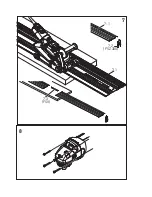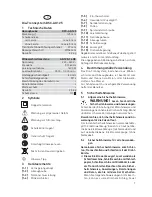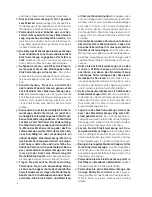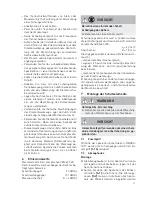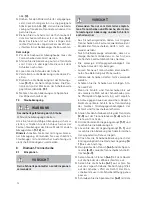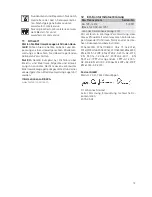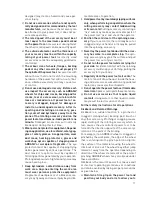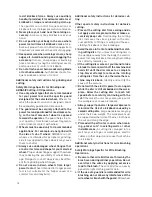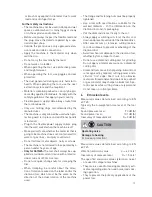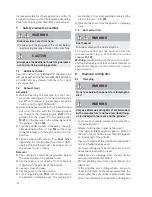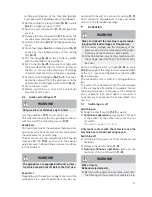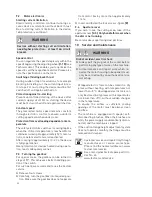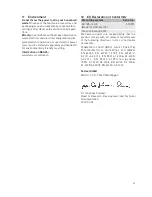
19
or brush may expand in diameter due to work
load and centrifugal forces.
Further safety instructions
-
The machine may not be used in damp and wet
spaces, outdoor when it is rainy, foggy or snowy
or in the explosive environment.
-
Before use always inspect the fl exible lead and
the plug. Have the defects repaired by a spe-
cialist repair shop.
-
Outside the premise use only approved exten-
sion leads and cable connections.
-
Apply the machine to the material only when
switched on.
-
Do not carry the machine by the lead.
-
Do not work on a ladder.
-
When operating the tool, use protective gloves
and tough footwear.
-
When operating the tool, use goggles and ear
protectors.
-
The dust generated during work is harmful to
health. When operating the tool, use the dust
extraction system and the respirator.
-
Materials containing asbestos can only be pro-
cessed by qualifi ed individuals. Comply with the
safety regulations that apply in your country.
-
Flexible power supply cable always route from
the tool backwards.
-
Only use milling rings recommended by the
manufacturer.
-
The machine is only allowed be used when pro-
tective guard is in place and additional handle
is fastened.
-
Plug in the fl exible power supply cable’s plug
into the wall socket when the machine is off.
-
Make yourself sure whether the material that is
going to be machined does not contain electric,
water or gas lines – an injury could occur.
-
Do not mill over metal objects, nails or screws.
-
The machine is not allowed to be operated by a
person under 16 years of age.
-
Only for AS/NZS:
The tool shall always be sup-
plied via residual current device with a rated re-
sidual current of 30 mA or less.
-
Do not use quick-change nuts for clamping the
disc.
-
When clamping, be careful about the direc-
tion of rotation marked on the label and/or the
diamond tool, which must be the same as the
direction of the actual rotation of the machine
used.
-
The fl ange and fastening nuts must be properly
tightened.
-
Use a tool with specifi cations suitable for the
worked material – cf. the information on the
diamond tool and its packaging.
-
Put the diamond disc vertically to the cut.
-
Always apply oscillating cuts to let the disc cool
down and prevent overload of the diamond disc.
-
After several cuts or intensive cutting make a
cool-down break to prevent overheating of the
diamond tool.
-
Avoid mechanical damage to the diamond tool,
whether by force, impact or heat.
-
Do not use a diamond cutting disc for grinding.
Do not apply a lateral pressure on a diamond
cutting disc.
-
Diamond tools are self-sharpening. A blunt tool
is recognised by reduced cutting power and a
circular “fi re” edge. Short cuts into abrasive
materials (limestone/sandstone bricks, asphalt
or gas concrete) may sharpen a blunt tool. Spo-
radic sparks while cutting stone are typical and
do not mean a critical problem.
6 Emission
levels
Measured values determined according to EN
60 745.
Typically the A-weighted noise level of the tool
are:
Sound pressure level:
90 dB (A)
Sound power level:
101 dB (A)
Inaccuracy of measurement
K = 3 dB (A)
CAUTION
Operating noise
Damage to hearing
Use ear protection!
Measured values determined according to EN
60 745.
Vibration emission value
a
h
= 4,0 m/s²
Inaccuracy of measurement
K = 1.5 m/s²
The specifi ed emissions values (vibration, noise)
-
are used to compare machines.
-
They are also used for making preliminary esti-
mates regarding vibration and noise loads dur-
ing operation.
-
They represent the primary applications of the
power tool.


